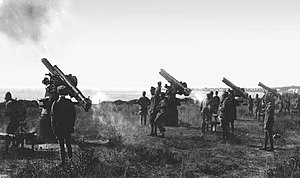| Cannone da 75/27 A.V. | |
|---|---|
 A Battery of 75/27 A.V. at the test range in Nettuno. A Battery of 75/27 A.V. at the test range in Nettuno. | |
| Type | Anti-aircraft gun |
| Place of origin | Italy |
| Service history | |
| In service | 1917–1943 |
| Used by | Italy Nazi Germany |
| Wars | World War I World War II |
| Production history | |
| Designed | 1916 |
| Manufacturer | Ansaldo |
| Variants | Autocannone da 75/27 C.K. |
| Specifications | |
| Mass | 1.9 t (1.9 long tons; 2.1 short tons) |
| Barrel length | 2.025 m (6 ft 8 in) L/27 |
| Shell | Fixed QF 75 x 185mm R |
| Shell weight | 6.5 kg (14 lb 5 oz) |
| Caliber | 75 mm (3 in) |
| Action | Semi-automatic |
| Breech | Horizontal sliding-wedge |
| Recoil | Hydro-spring |
| Elevation | –5° to +80° |
| Traverse | 360° |
| Rate of fire | 15 RPM |
| Muzzle velocity | 510 m/s (1,700 ft/s) |
| Effective firing range | 5,500 m (18,000 ft) |
| Maximum firing range | 6,000 m (20,000 ft) |
The Cannone da 75/27 A.V. was an anti-aircraft gun developed in Italy during the First World War that also saw service during the Second World War.
History
The 75/27 A.V. (Anti Velivolo, Anti-Aircraft) cannon was privately developed by Ansaldo to supply an anti-aircraft gun to the Regia Esercito.
Technical
The 75/27 A.V. used the barrel and hydro-spring recoil mechanism from the Cannone da 75/27 modello 06 a license-built version of the Krupp Kanone M 1906 field gun to speed up production and it used the same Fixed QF 75 x 185mm R ammunition. The barrel consisted of a rifled liner with 28 left-handed grooves, and an external jacket, it was 2.025 m (6 ft 8 in) L/27 long and weighed 346 kg (763 lb) including the semi-automatic horizontal sliding-wedge breech. The breech closed automatically when a projectile was fed into the chamber and after firing the shell casing was ejected and the breech was held open for the next round.
Variants
- The 75/27 A.V. - was mounted on a static center pivot mount with -5° to + 80° of elevation and 360° of traverse. The 75/27 A.V. was used during the First World War for the defense of metropolitan areas by the Regia Esercito. During the Second World War it was assigned to coastal defense, anti-aircraft, and second line units.
- The Autocannone da 75/27 C.K. - was a self-propelled anti-aircraft gun with a new pedestal mount and new recoil mechanism that was mounted on the chassis of a Lancia 1Z truck. In 1915 these formed the basis of Italy's first truck-mounted artillery. Eventually, twenty-seven batteries of five guns were formed during World War I.
Notes
- "75-77 MM CALIBRE CARTRIDGES". www.quarryhs.co.uk. Archived from the original on 2017-10-11. Retrieved 2017-09-04.
- ^ Cappellano, Filippo (1998). Le artiglierie del Regio Esercito nella Seconda Guerra Mondiale. Parma: Albertelli. ISBN 88-87372-03-9. OCLC 48876309.
- Chamberlain, Peter (1975). Anti-aircraft guns. Terry Gander. New York: Arco Pub. Co. ISBN 0-668-03818-7. OCLC 2000222.
- Riccio, Ralph A. (2010). Italian truck-mounted artillery in action. Nicola Pignato, Matheu Spraggins. Carrollton, TX: Squadron/Signal Publications. ISBN 978-0-89747-601-0. OCLC 917891702.
References
- Filippo Cappellano, Le artiglierie del Regio Esercito nella Seconda Guerra Mondiale, Storia Militare, 1998.
- Chamberlain, Peter & Gander, Terry. Light and Medium Field Artillery. New York: Arco, 1975.
- Ralph A Riccio, Italian truck-mounted artillery in action Carrollton, TX: Squadron Signal, 2010.
See also
External links
- Scheda sul sito dell'associazione "Custodia del Grifo Arciere" Archived 2015-09-24 at the Wayback Machine
- Scheda su regioesercito.it
| Italian artillery of World War I | |
|---|---|
| Anti-aircraft guns | |
| Field, Medium and Heavy guns | |
| Mortars | |
| Infantry and Mountain guns | |
| Naval and coastal defense guns |
|
| Railroad artillery | |
| Superheavy and Siege artillery | |
| Italian artillery of World War II | |
|---|---|
| Tank guns | |
| Anti-tank guns | |
| Infantry and Mountain guns | |
| Field, Medium and Heavy guns |
|
| Superheavy and Siege artillery | |
| Railroad artillery | |
| Anti-aircraft guns | |